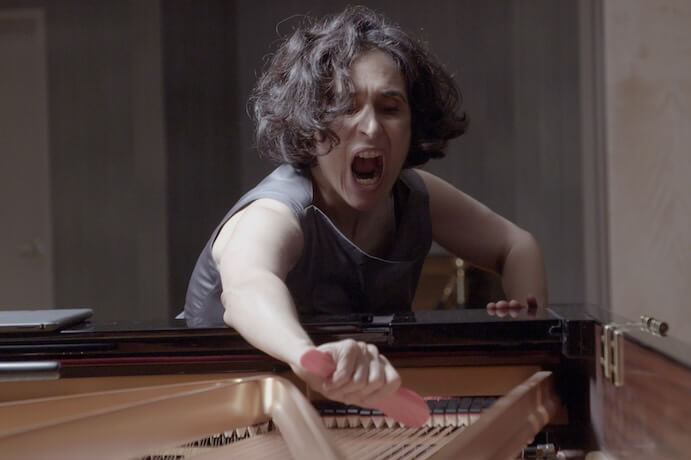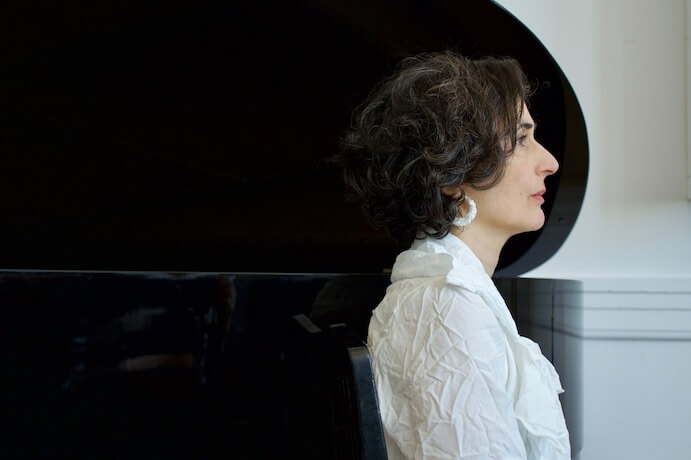As a prominent figure in contemporary classical music, pianist Eve Egoyan has spent the last 30 years expanding the capabilities of the piano as a solo instrument. Her lengthy list of accolades and achievements includes CBC’s list of top 25 Canadian pianists of all time and a discography brimming with premieres. For decades, Egoyan has consistently delivered programs and albums with a clear artistic intention and a refined sonic profile. But even with this prolific output, it is still impossible to find a single label capable of defining her broad range of styles and interests. At present, her performance repertoire is an eclectic mix, spanning from Erik Satie to Ann Southam to her own recent composition inspired by pioneering Armenian musicologist, Komitas Vardapet.
One word that does encompass Egoyan’s work is visionary. Her experimental blend of technology and acoustics reveal her as an artist who is peering beyond the veil of convention, searching for increasingly expressive ways to create at the piano, even in the face of various obstacles. The cumbersome nature of pedals, triggers, projectors, and cords can turn the inclusion of electronics and multimedia into a messy distraction rather than a vehicle for artistic expression. But Egoyan’s masterful execution of these technological elements in performance allows her to elevate her expansive, sonorous playing to almost transcendent heights.
For her upcoming concert, presented by TO Live at the Meridian Arts Centre, Egoyan pays tribute to her Armenian heritage by showcasing works written by composers from Armenia and the Armenian Diaspora: Egoyan herself, Boghos Gelalian, Narine Khachatryan, Mary Kouyoumdjian, Tigran Mansurian, and Vardapet, most of which are Canadian premieres. In advance of the May 9 performance, we asked her about the inspiration behind this program and more.
Your varied repertoire and creative interests include folk music, extreme minimalism, augmented piano, and multimedia. How do you see these different facets of your work intersecting and complementing each other?
My artistic medium is the piano. I have rooted and evolved my creative practice inside the piano’s sound for over 40 years. I follow my curiosity through my deep connection with the instrument as an extension of who I am as an artist. I chose my repertoire carefully and subjectively. Each composer I choose to play has a unique compositional language and a connection to the piano. The various types of music I play represent me and the breadth of my interests. By choosing to perform primarily music of my own time, I am seeking to continually re-create the piano for myself and for my audiences. My interest in folkloric idioms is woven throughout my career. However only recently have I explored my own ancestral folkloric music. I am moved by the idea of fragments, layers, familiar languages that surface within the unfamiliar, a search for something lost.
For myself as a creator, I have delved into the space between what a piano can do and what I have always wished a piano could do. I call these explorations PIANO NEXT. PIANO NEXT’s earliest explorations focused on the visualization of sound. In Surface Tension, co-created with media artist David Rokeby, my performance at an acoustic piano equipped with a keyboard interface is transformed and interpreted by a computer into live visual images projected onto a screen rising from the body of the piano extending the piano into a visual instrument as well as a musical one.
More recently I have been playing with extending the piano’s sound. Coupling the piano with software that models the behaviour of a physical piano, I have gained the ability to shadow the acoustic piano with a virtual piano that allows me to augment and extend its sonic range in ways long dreamt of but never yet achieved (for example pitch bend, sustaining a note indefinitely, vibrato, harmonic filtering…). At PIANO NEXT’s core is the live acoustic sound of the piano, but the delicate intervention of technology pushes it beyond the familiar, through the impossible, and into the extraordinary both sonically and visually.
The May 9 concert seems to hold a lot of personal significance coming after your first visit to Armenia. Would you tell us about your process in curating the program?
In the spring of 2022 I travelled to Armenia for the first time. There I connected to music by living Armenian composers and charted new emotional territory for myself. I am Armenian-Canadian, born in Canada to Armenian parents. My father’s parents were both orphans of the Armenian genocide. Through this programme, “Longing and Belong,” I am seeking a point of intersection between my Armenian heritage and my musical practice which includes the commitment to music of my own time, a strong curatorial vision and gender-balanced programming. The programme brings together composers living in present day Armenia and Armenians from the diaspora (Armenians living outside of Armenia).
Armenian history is a complicated one. Through the genocide and subsequent diaspora we have lost ties to our historic past. I hope to find a musical place for myself between remnants of the past and the energy of the present to create a musical place of my own. Though I will never be able to return to my ancestral home without being fully aware of its violently destructive past and uncertain future, I hope to find something safe for me nestled within its extraordinarily rich and ancient culture.

Eve Egoyan — Photo by Su Rynard
The work of Komitas Vardapet is the basis for your composition, Ghosts beneath my Fingertips. How is Komitas’ influence felt in your piece, and in the program as a whole?
I received an arts grant to travel to Armenia. When COVID-19 delayed this travel, I decided to reach into a collection of songs by the Armenian composer Komitas (who was also the most important collector of Armenian folk songs) to write a work for myself. Using an extremely subjective process, I selected fragments from the songbook and created the compositional fabric keeping the original keys of the songs and allowing myself to create using material based on the pitches within each song. It was my desire to avoid obscuring the delicacy of Armenian folk tunes with western European harmony. This piece is dedicated to my daughter, Viva, and includes her wonderful voice. Komitas’ exquisite Seven Dances for the piano are extraordinary in their adherence to the delicacy of Armenian folk music and their re-imagined location on the piano, a deeply European instrument. They are neither true folklore nor traditional piano pieces yet they are true to both.
Each work on my programme touches on Armenian folkloric elements in some way. The country where each composer is actually living and writing, clearly and unexpectedly colours their music as well. This adaptation to physical environment (a type of survival) forces a blending which is both loss and a movement in time which cannot be helped. In this way, each composition on my programme reflects its full lineage, ancestral and present.
I’m curious about your transition from your classical training to focusing on performing modern music. What were some of the factors that motivated the change?
I was born in Victoria, B.C. where I also completed my undergraduate degree at the very lively music department in the University of Victoria. When I arrived in Toronto after studying standard repertoire in Europe for four years (DAAD scholarship – Berlin, Germany – and Commonwealth scholarship – London, UK) many of the composers who I met as an undergrad in Victoria had relocated to Toronto. These composers include Linda Catlin Smith, Martin Arnold, Stephen Parkinson and Allison Cameron. I started performing their music. After studying standard repertoire, I was inspired to be working with these living composers.
So much of my time as an interpreter of classical repertoire was about trying to get close to the creative source through various editions and imagined contexts (for example, what was the authentic instrument a work was written for). By playing music of my own time, I had the possibility to actually ask my composers about their intentions or clarifications about their scores. I was also performing on the instrument the music was intended and performing in venues that matched the world in which the music was created. Most of my thirteen discs include works that I premiered or were written for me.
One perceptible theme of your career is that you are constantly pushing boundaries of what is possible for the piano as a solo instrument; so, I have to ask: what can we expect from you next?
Presently I am working with the amazing animator Christopher Hinton on touch-triggered animations. We are creating in tandem, sharing back and forth compositional material and visual material, then binding the images to the music so that I can stay free in time as I play. I am not keen on playing with click track as it does not allow me to adjust to the instrument I am performing or respond to my acoustic environment. As in the piece Surface Tension created with media artist David Rokeby, I am always seeking ways that image and sound can be fully interwoven. Most of the time music supports image. I want to redress this imbalance.
My most recent CD Hopeful Monster (2023) is a collaboration with Vancouver-based Costa Rican composer/performer Mauricio Pauly. The music on Hopeful Monster was created spontaneously through a distinctive joint vision. I perform on acoustic and augmented piano (manipulation of a modelled piano as well as acoustic samples) and Mauricio performs with live samplers, live processing, dekeyed chromaharp, and drum bundle. Our co-creative and improvisational world is an ongoing exploration of our compelling and often unexpected intersection.
I have been collaborating with several visual artists providing music for their installations and videos. Most recently I completed a project creating sound for an installation by the visual artist Lyla Rye called Clear Cut and will presently be completing a miniature on a series about trees. There is also an ensemble based in Montreal who has asked me to write a piece for them with augmented piano. This will be quite a challenge as I have only, as yet, written for solo piano. I also want to re-visit and curate a series of programmes delving into the amazing works that have been written for me mixed with works by the iconoclastic and remarkable composer from the turn of the century Erik Satie.
I CARE IF YOU LISTEN is an editorially-independent program of the American Composers Forum, and is made possible thanks to generous donor and institutional support. Opinions expressed are solely those of the author and may not represent the views of ICIYL or ACF.
You can support the work of ICIYL with a tax-deductible gift to ACF. For more on ACF, visit the “At ACF” section or composersforum.org.





















